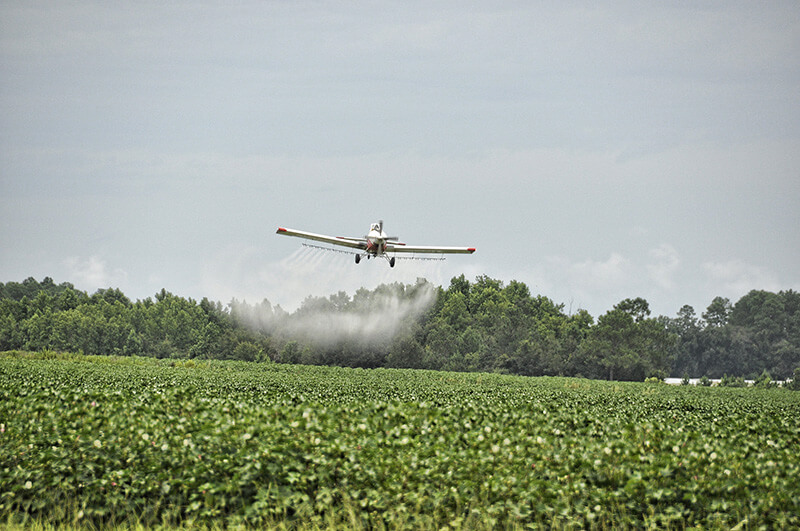June 25, 2020
Chemicals released into the air could become less hazardous, thanks to a missing math formula for droplets

A new math formula could give aerial crop sprayers more control over tiny droplets, preventing wind from carrying pesticides off-target. (Pixabay image/Jan Amiss)
Discovery of how to measure surface viscosity of liquids could give machines more precise control over droplets
WEST LAFAYETTE, Ind. — Drones and other aircraft effectively spray pesticides over miles of crops, but the method also can pollute the environment if wind carries the mist off-target.
One of the problems is that tiny droplets are hard for aerial crop sprayers, inkjet printers and a wide range of other machines to control. Purdue University engineers are the first to come up with the math formula that was missing to measure a key property of these droplets.
“There are many properties that affect how a droplet forms. One of those important properties is surface viscosity, which people have had a heck of a time trying to measure because they just didn’t have the tools to do it,” said Osman Basaran, Purdue’s Burton and Kathryn Gedge Professor of Chemical Engineering.
Pesticides and other chemicals contain additives called surfactants. These surfactant molecules resist each other at a liquid’s surface, giving rise to a sticky force called surface viscosity that can make the droplet smaller. The higher the surface viscosity, the more compact a droplet’s shape.
Basaran and his students have figured out a way to calculate surface viscosity just by looking at how a droplet stretches. A picture taken of the stretched droplet as it starts to break gives the values to put into a simple math formula that provides the surface viscosity measurement.
The formula is described in a paper published in the journal Physical Review Letters. The discovery ends a decades-long race by researchers around the world to make surface viscosity measurable. Other co-authors on this paper include Hansol Wee, Brayden Wagoner and Pritish Kamat.
Not being able to measure exactly how much surface viscosity affects drop formation has put limits on making machines safer and more precise, said Basaran, who directs a center that works to resolve the science behind problems in manufacturing machinery.
 Purdue researchers have figured out a way to calculate surface viscosity just by looking at a stretched droplet as it starts to break. (Purdue University images/Brayden Wagoner and Osman Basaran)
Download image
Purdue researchers have figured out a way to calculate surface viscosity just by looking at a stretched droplet as it starts to break. (Purdue University images/Brayden Wagoner and Osman Basaran)
Download image
Solutions provided by the center, called the Purdue Process Safety and Assurance Center, directly help partners in industries such as agriculture, health care and energy.
A better understanding of droplets and how to control them affects all those industries. Like crop spraying, inkjet printing in a factory produces tiny droplets that can get into the air and cause breathing problems.
More precise control of a liquid-like substance also could enhance a machine’s performance, such as giving a 3D printer the ability to produce more reliable or detailed objects.
“A material with too high or too low surface viscosity can lead to bad outcomes in the manufacturing process. Knowing those measurements allows you to use different chemistries to make a material that doesn’t lead to a surface viscosity that’s going to result in a bad outcome,” Basaran said.
Next, Basaran’s team plans to incorporate this math formula into experiments for recommending new machine designs. The formula could also become a commercial instrument in the future, such as a smartphone app.
“This discovery opens up a lot of avenues for basic research that just weren’t possible before,” Basaran said.
This research received no external funding.
About Purdue University
Purdue University is a top public research institution developing practical solutions to today’s toughest challenges. Ranked the No. 6 Most Innovative University in the United States by U.S. News & World Report, Purdue delivers world-changing research and out-of-this-world discovery. Committed to hands-on and online, real-world learning, Purdue offers a transformative education to all. Committed to affordability and accessibility, Purdue has frozen tuition and most fees at 2012-13 levels, enabling more students than ever to graduate debt-free. See how Purdue never stops in the persistent pursuit of the next giant leap at purdue.edu.
Writer: Kayla Wiles, wiles5@purdue.edu (working remotely, but will provide immediate response)
Source: Osman Basaran, obasaran@purdue.edu
ABSTRACT
Effects of surface viscosity on breakup of viscous threads
Hansol Wee, Brayden W. Wagoner, Pritish M. Kamat, and Osman A. Basaran,
Davidson School of Chemical Engineering, Purdue University, West Lafayette, Indiana 47907, USA
DOI: 10.1103/PhysRevLett.124.204501
In addition to surface tension lowering and Marangoni stresses, surfactants also induce surface rheological effects when they deform against themselves at fluid interfaces. Because surface viscosities are functions of surfactant concentration, surface rheological stresses can compete with capillary, Marangoni, and bulk stresses in surfactant-laden free surface flows with breakup. To elucidate the effects of surface rheology, we examine the breakup of a Stokes thread covered with a monolayer of insoluble surfactant when either surfactants are convected away from the space-time singularity or diffusion is dominant. Surprisingly, in both limits, surface rheological effects always enter the dominant balance of forces and alter the thread's thinning rate. Moreover, if surfactants are convected away from the singularity, we provide an analytical expression for thinning rate that explicitly depends on surface rheological parameters, providing a simple route for measuring surface viscosity.

